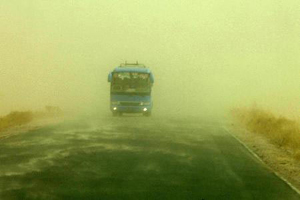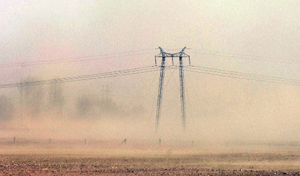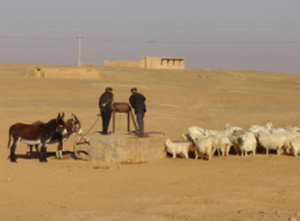| Tools: Save | Print | E-mail | Most Read |
| N. China Desertification Critical |
| Adjust font size: |
Since February, northern parts of
The dire situation begs the question: "Just who or what is to blame; Nature, man or both?" When conditions were particularly bad between April 9 and 11, a journalist from the Beijing-based newspaper China Business News went to the Alxa League of Inner Mongolia Autonomous Region, said to be the "heart" of the sandstorms, in search of an answer. "The frequency of sandstorms in recent years has continued to rise, in terms of force as well, and affecting more areas. I think the reason comprises both natural and human factors," said Xiang Ming, deputy director of the Science and Technology Bureau of the Alxa League. Increased human activity in terms of over-exploitation of land and groundwater resources has caused severe water shortages and desertification. Results from surveys conducted by a non-governmental organization, the Alxa Society Entrepreneur Ecology (SEE), show that the most serious ecological deterioration of the Alxa region is fairly recent, having taken place only over the past few decades. Alxa is
The Alxa Plateau is surrounded by mountains and most of it is desert with drifting dunes. Some 82.3 percent of the area is desert. The Ulan Buh and Badain Jaran deserts sprawl across an additional eight to 20 meters every year. "These sandstorms are the most serious I've witnessed in recent years," Xiang said. "I've lived here for over 50 years. Compared with the time when I was young, sandstorms now have become more and more frequent and severe, and the eco-environment worse and worse." Relevant documents show that although Alxa has always been a predominantly desert area, it was once a good habitat for livestock because it has three eco-protective screens that run in three directions, namely the primitive secondary forests in Helan Mountain to the east, poplar forests in the Ejin Banner in the Heihe River basin to the west, and saksaul forests to the north. Deng Yi, vice secretary of SEE, said: "It is a pity that the quality of the three natural screens has degraded over the years, a situation that has directly resulted in water shortages in rivers, a sharp reduction in bio-diversity, and desertification. The sandstorms have exerted an unfortunate influence on global weather conditions as well." According to an SEE survey, pastureland in Alxa is shrinking by 26,000 mu ( Changes in modes of production have also led to a dramatic drop in groundwater levels. Corn and other crops that need large amounts of water were planted in great numbers with the shift from animal husbandry to agriculture.
In an attempt to control the situation, herdsmen were relocated from severely deteriorated pastureland in the hope that nature would take its course and rejuvenate the damaged land. However, Deng believes that this method will prove ineffective. According to SEE studies, allowing pastureland to lie idle exposes the land to the risk of rat damage and fire. Damage caused by human beings and livestock is not as serious as a water shortage. This is the view shared by many herdsmen who believe that there can be no improvement without water, even if grazing is stopped. "Relocation isn't all there is to it," Deng said. "It is very necessary to adopt a scientific method of irrigation in the desert areas to the west," an irrigation expert with the Ministry of Science and Technology, Qiu Weiduo, told China Business News. He said that the current method of "flooding irrigation" has to be changed. Further, more should be done to exploit local conditions including long periods of sunshine and good natural soil texture. Another method, according to Xiang Ming, is to conduct artificial control in small areas. A research project into technologies for recovering ecology damaged through desertification has been approved by the State Science and Technology Commission. The Cold and Arid Regions Environmental and Engineering Research Institute of the Chinese Academy of Sciences (CAS) will take charge of the project. According to initial research results from the research institute, only 10 percent of desert land has been brought under proper control and 12 percent rehabilitated to varying degrees, in spite of the time and money spent on desert management by the central government. Partial control and overall deterioration have not changed fundamentally. A series of tree-planting projects were launched in recent years, but experts say that these projects have not been very successful because research into the cause and process of desertification has been inadequate. Chen Guangting, an expert from the research institute, said that 90 percent of desert land in Liu Tuo, director of the Sand Prevention and Control Office of the State Forestry Administration, verified that (China.org.cn by Zhang Tingting, April 19, 2006) |
| Tools: Save | Print | E-mail | Most Read |
 |
| Related Stories |
| Product Directory China Search |
Country Search Hot Buys |


